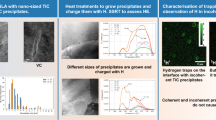Abstract
A mathematic model has been presented to predict the decarburization kinetics of grain-oriented silicon steel sheet in the gas mixture of N2–H2–H2O during annealing. This model is based on the carbon flux balance between the oxidation reaction at the surface and the carbon diffusion inside the steel sheet. It can be numerically solved to quantify the influences of annealing temperature and atmosphere on decarburization kinetics when the boundary conditions are properly determined. In case that a humid gas mixture is employed during annealing, the most influential process parameter is temperature rather than compositions of the gas mixture, because the diffusion of carbon in ferrite is the rate-limiting step. Therefore, a higher temperature is required for the efficient decarburization of the thicker silicon steel sheet using the industrial continuous annealing production line.







Similar content being viewed by others
References
Beckley P (2000) European electrical steels. Orb Works, Wales, pp 372–375
He ZZ, Zhao Y, Luo HW (2012) Electrical steels (in Chinese). Metallurgy Industry Press, Beijing, pp 422–423
Gunther K, Bolling F, Huneus H (1988) Detrimental effect of oxidation on magnetic properties of nonoriented electrical steel sheet. J Appl Phys 64:5347–5357
Jiles D (1991) Introduction to magnetism and magnetic materials. Chapman & Hall, London, p 272
Korousic B, Jenko M, Stupnisek M (2002) The gas composition that causes oxide scale formation during the decarburization of non-oriented electrical steel sheets. Steel Res 73:63–68
Soenen B, Jacobs S, De Wulf M (2005) Modelling decarbruization kinetics in electrical steels. Steel Res Int 76:425–428
Swisher JH, Turkdogan ET (1968) Decarburization of iron-carbon melts in CO2-CO atmospheres; Kinetics of gas-metal surface reactions. Trans Metall Soc AIME 242:763–765
Pyyry J, Kettunen P (1973) Decarburization in plain carbon steel. Scand J Metall 2:265–268
Marder AR, Perpetua SM, Kowalik JA et al (1985) The effect of carbon content on the kinetics of decarburization in Fe-C alloys. Metall Trans A 16A:1160–1163
Marini P, Abbruzzese G (1982) Decarburization rate related to surface oxidation of grain oriented silicon steel. J Magn Magn Mater 26:15–21
Toda H, Sato K, Komatsubara M (1997) Characterization of internal oxide layers in 3% Si grain-oriented steel by electrochemical methods. J Mater Eng Perform 6:722–727
Cesar MDMM, Mantel MJ (2003) Effect of the temperature and dew point of the decarburization process on the oxide subscale of a 3% silicon steel. J Magn Magn Mater 254–255:337–339
Author information
Authors and Affiliations
Corresponding author
Additional information
SPECIAL ISSUE: Materials Genome
About this article
Cite this article
Luo, HW., Xiang, R., Chen, LF. et al. Modeling decarburization kinetics of grain-oriented silicon steel. Chin. Sci. Bull. 59, 1778–1783 (2014). https://doi.org/10.1007/s11434-014-0156-2
Received:
Accepted:
Published:
Issue Date:
DOI: https://doi.org/10.1007/s11434-014-0156-2




